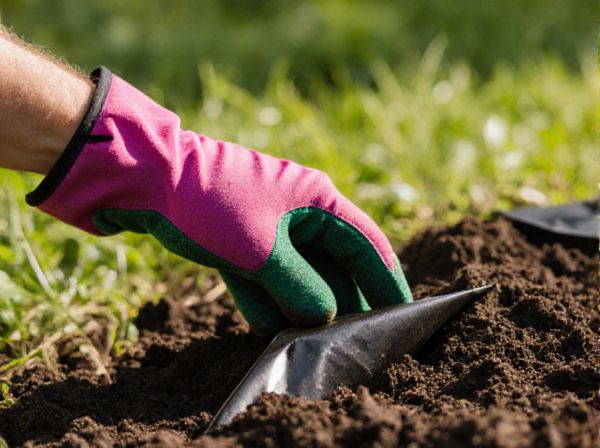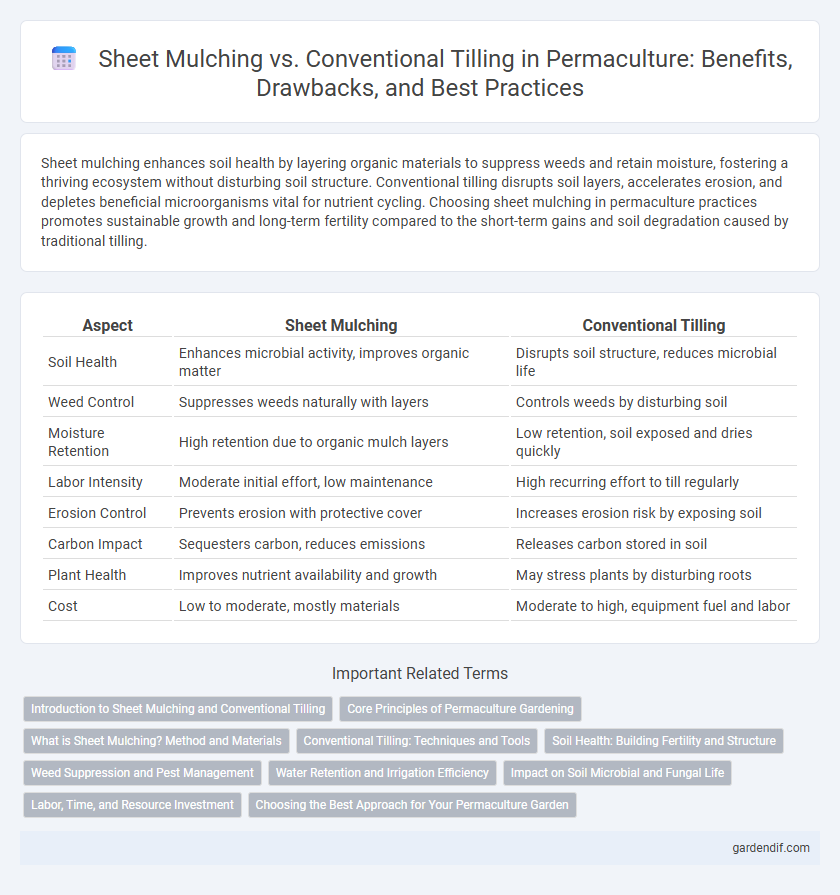
sheet mulching vs conventional tilling Illustration
Sheet mulching enhances soil health by layering organic materials to suppress weeds and retain moisture, fostering a thriving ecosystem without disturbing soil structure. Conventional tilling disrupts soil layers, accelerates erosion, and depletes beneficial microorganisms vital for nutrient cycling. Choosing sheet mulching in permaculture practices promotes sustainable growth and long-term fertility compared to the short-term gains and soil degradation caused by traditional tilling.
Table of Comparison
| Aspect | Sheet Mulching | Conventional Tilling |
|---|---|---|
| Soil Health | Enhances microbial activity, improves organic matter | Disrupts soil structure, reduces microbial life |
| Weed Control | Suppresses weeds naturally with layers | Controls weeds by disturbing soil |
| Moisture Retention | High retention due to organic mulch layers | Low retention, soil exposed and dries quickly |
| Labor Intensity | Moderate initial effort, low maintenance | High recurring effort to till regularly |
| Erosion Control | Prevents erosion with protective cover | Increases erosion risk by exposing soil |
| Carbon Impact | Sequesters carbon, reduces emissions | Releases carbon stored in soil |
| Plant Health | Improves nutrient availability and growth | May stress plants by disturbing roots |
| Cost | Low to moderate, mostly materials | Moderate to high, equipment fuel and labor |
Introduction to Sheet Mulching and Conventional Tilling
Sheet mulching enhances soil health by layering organic materials such as cardboard, compost, and mulch, promoting moisture retention and weed suppression while supporting microbial activity. Conventional tilling disrupts soil structure, leading to erosion, loss of nutrients, and reduced microbial diversity. In permaculture, sheet mulching is favored for creating sustainable, fertile soil ecosystems without harmful soil disturbance.
Core Principles of Permaculture Gardening
Sheet mulching supports permaculture's core principles by enhancing soil health through organic matter layering, promoting biodiversity, and reducing erosion compared to conventional tilling's soil disturbance. This method fosters natural nutrient cycling and moisture retention, aligning with permaculture's emphasis on mimicking natural ecosystems. In contrast, conventional tilling disrupts soil structure, leading to increased erosion and loss of beneficial microorganisms key to permaculture's sustainable gardening practices.
What is Sheet Mulching? Method and Materials
Sheet mulching is a permaculture method that builds fertile soil layers by stacking organic materials such as cardboard, newspaper, compost, straw, and mulch directly on the ground without disturbing the existing soil structure. This technique suppresses weeds, retains moisture, and promotes beneficial microbial activity by mimicking natural forest floor processes. Unlike conventional tilling, which disrupts soil biology and structure, sheet mulching enhances soil health and increases long-term productivity through a no-dig, layered approach.
Conventional Tilling: Techniques and Tools
Conventional tilling involves using tools like rototillers, plows, and harrows to break up soil for planting, which temporarily improves aeration and weed control. However, frequent tilling can disrupt soil structure, reduce microbial life, and increase erosion risks, contrasting with permaculture principles. Techniques often emphasize deep tilling to incorporate organic matter but may lead to long-term fertility decline compared to no-till or sheet mulching methods.
Soil Health: Building Fertility and Structure
Sheet mulching enhances soil health by promoting natural microbial activity and improving soil structure through layered organic matter decomposition, leading to increased fertility and moisture retention. Conventional tilling disrupts soil aggregates, reduces microbial diversity, and accelerates erosion, which depletes nutrient availability and degrades soil quality over time. Sustainable permaculture practices prioritize sheet mulching to build resilient, fertile soils that support long-term plant growth and environmental balance.
Weed Suppression and Pest Management
Sheet mulching enhances weed suppression by creating a thick, decomposing organic layer that blocks sunlight, preventing weed seed germination and reducing manual weeding efforts. Unlike conventional tilling, which disturbs soil structure and can bring weed seeds to the surface, sheet mulching maintains soil integrity and fosters beneficial microbial activity that naturally deters pests. This method supports healthier soil ecosystems, promoting long-term pest management without relying on chemical interventions.
Water Retention and Irrigation Efficiency
Sheet mulching significantly improves water retention by creating a protective layer that reduces evaporation and enhances soil moisture levels, unlike conventional tilling which disrupts soil structure and accelerates water loss. This method increases irrigation efficiency as the mulch acts as a sponge, allowing water to penetrate deeper and remain available for plant roots longer. In contrast, conventional tilling often results in compacted soil and runoff, reducing the effectiveness of irrigation efforts.
Impact on Soil Microbial and Fungal Life
Sheet mulching enhances soil microbial and fungal diversity by providing a natural, undisturbed habitat rich in organic matter, fostering beneficial fungi like mycorrhizae that improve nutrient uptake. Conventional tilling disrupts soil structure, damaging fungal networks and reducing microbial populations, leading to decreased soil fertility and increased erosion risk. Maintaining intact soil ecosystems through sheet mulching promotes long-term soil health and sustainable plant growth.
Labor, Time, and Resource Investment
Sheet mulching significantly reduces labor and time compared to conventional tilling by layering organic materials directly on the soil, eliminating the need for intensive digging or turning. Resource investment in sheet mulching is often lower as it utilizes readily available materials like cardboard, straw, and compost, enhancing soil health without synthetic inputs. In contrast, conventional tilling demands heavy machinery, fuel, and frequent soil amendments, increasing both environmental impact and long-term maintenance efforts.
Choosing the Best Approach for Your Permaculture Garden
Sheet mulching enhances soil health by mimicking natural forest floor processes, improving moisture retention, suppressing weeds, and promoting beneficial microbial activity. Conventional tilling disrupts soil structure, leading to erosion and loss of organic matter, which can hinder long-term permaculture goals. Choosing sheet mulching supports sustainable soil regeneration and aligns with permaculture principles of minimal disturbance and ecosystem diversity.
sheet mulching vs conventional tilling Infographic

 gardendif.com
gardendif.com